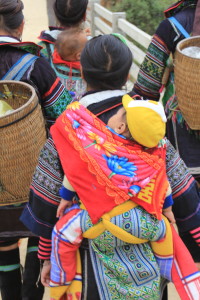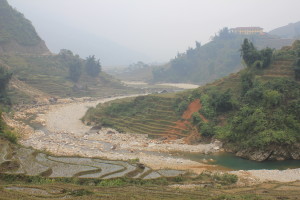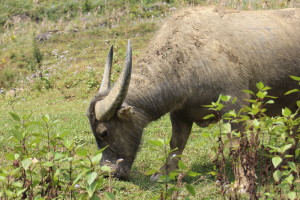So, the train ride up to the mountains was basically the equivalent of the Thunder Mountain Roller Coaster at Disney Land. I am certain that I actually lifted off my bunk on a couple of those drops. It became clear why they had installed railing along the side of each bunk to keep people from flying out! We didn’t see much of anything during the night but the few glimpses of lights we saw were of houses set no more than 5-10 feet off the tracks. We were literally barreling through people’s yards at what seemed like a terrifying speed. Probably for best they only run the trains at night for that reason. When we left the station in Hanoi it looked as if they just line several trains up and do kind of a Cannonball Express to Laos.
Sapa is at about 4,500 feet elevation and is much more wet and cold than Hanoi. It’s been misty and in the 50’s with light rain starting today. Basically Vanessa and I feel we are back in San Francisco summer conditions. “Goodbye flip flops, we had a nice couple of days together”. The mountains around Sapa are the highest in Vietnam with Mt. Fanistan rising to around 14000 feet. A three day epic adventure to reach the summit we hear…with a wide variety of poisonous snakes along the way. Come to think of it, I have never seen a Cobra up close, well, maybe next time.
The valley drops a thousand feet or more below us to a series of rivers an waterfalls with villages nestled along the slops above. We hiked 18k along narrow paths and wider roads to the villages of Cat Cat and Lao Chai. The Black Hmong people live here along with many other ethnic minorities which can be differentiated by clothing colors and styles. The Black Hmong are named after the dark black/purple clothing they are wrapped it. They grow indigo here and use that to create the dark purple color for there clothing which they wrap head to foot with many layers of vibrant colored needle point stitching worked into their accessories. The “Baby Bjorns” are the most beautiful patterns and colors and the have the baby cocooned into a hand made one-zy which straps them onto the women’s backs for the entire day.
There are no men here, or boys older than 10, which we are told is because the men live in the mountains hunting and collecting medicinal herbs all year. Many of the herbs i recognize in the market but many I do not. I get looked at strangely when I mention Chinese medicinal uses. Its apparent that herbal medicine varies greatly country to country and i am told again, “the Chinese are not popular here.” Because the Rice is planted in May and harvested in August, only one cycle a year here due to the cold, the women have nothing to do this time of year and are forced by the men to hike up to Sapa every day to try and sell small crafts to the tourist. Despite the absence of men we are told life for women is very hard, marriage is done through a type of kidnapping of a young girl for three days. Then her father comes and asks if she wants to marry the boy. She can say no but would be an outcast with little chance of marriage in the future if she did so. After hearing this I kept a sharp eye of Vanessa since we were hear for exactly three days making her perfect bait for a Hmong kidnapping! In truth, after one suspiciously long trip to the bathroom after lunch our guide suggested the possibility to me that she had been taken, I assured him that she had way more sass in her than Hmong men were prepared to take on!
There are no men here, or boys older than 10, which we are told is because the men live in the mountains hunting and collecting medicinal herbs all year. Many of the herbs i recognize in the market but many I do not. I get looked at strangely when I mention Chinese medicinal uses. Its apparent that herbal medicine varies greatly country to country and i am told again, “the Chinese are not popular here.” Because the Rice is planted in May and harvested in August, only one cycle a year here due to the cold, the women have nothing to do this time of year and are forced by the men to hike up to Sapa every day to try and sell small crafts to the tourist. Despite the absence of men we are told life for women is very hard, marriage is done through a type of kidnapping of a young girl for three days. Then her father comes and asks if she wants to marry the boy. She can say no but would be an outcast with little chance of marriage in the future if she did so. After hearing this I kept a sharp eye of Vanessa since we were hear for exactly three days making her perfect bait for a
Hmong kidnapping! In truth, after one suspiciously long trip to the bathroom after lunch our guide suggested the possibility to me that she had been taken, I assured him that she had way more sass in her than Hmong men were prepared to take on!
With marriage as early as 14 and 4-5 kids on the way life revolves around rice here. Each Hmong person will eat up to 2-2.5 kilos of rice per day. This means that they eat as much or more than they can grow despite the land being completely covered in a network of terraces. Hemp for making the clothes and Indigo for dying seem to be the only other cultivated crops. Bamboo and a very bountiful and wide variety of vegetables grow around the homes. Pumpkins dry of the roofs while women work turning the bamboo, after being hardened under the mud for 3 months, into everything from irrigation piping, to fencing, to roofing and ladders. Each home has a stand of Banana which they use for fruit, Banana blossom dishes, and for feeding the animals. Young children run through the streets rolling old motorcycle tires with bamboo sticks or sit and extract the young bamboo shoots for eating…which they seem to eat one of for every three that go in the basket. Big potbellied pigs and piglets wander everywhere, mixing it up with the dogs every house owns, and fighting for bugs with a wide variety of ducks and chickens. All of which, dogs too, go into the cooking pot when they grow old enough. The king of the land here is the water buffalo which roam through the paddies eating the weeds and fertilizing the fields. When they can no longer plow the paddies they too go into the food cycle but at 15 dollars a kilo they are sold to the more wealthy Viet majority who can afford them. Invaluable as a natural tractor for the farmers, they are members of the family, who until recent health education programs, have lived in the homes with the farmers. What few old
men we saw in the village were gathered around watching a Cock fight which we joined for a few minutes. I was invited to lay some money down but when I was told that neither of the birds were named “Little Jerry Seinfeld” I was lost as to who I should bet on.
Schooling is frowned upon here despite the work of many NGOs and expatriates. Parents see it as pointless since all the children return to the village life/culture afterwards. We were told that only 2 children have ever made it out of the village to university so far, the pressure to stay is so strong.
The town of Sapa is a old French resort town, they came in 1908 and were kindly asked to leave in 1978, with Alps style hotels looking over the valley. The tourist here seem overwhelmingly French with a smattering of Aussies, Germans, and Brits. There is Northface clothing sold everywhere and is very good knock off quality. Owning the real thing myself at home, I cannot tell the difference, all goretex and all very quality. We got a $250 parka for $38 dollars here and it seems to be a perfect copy. For my birthday Vanessa gets a present?? They also sell a great deal of the bright clothing and needle work here for very cheap. It’s seems to be way too much inventory for the women to make and we wonder if there is a factory nearby cranking it out under the allusion of being local. We got some things in the small village with the hopes the money would stay there.
The village has changed dramatically in five years and no doubt will continue as more tourist visit in the next five. The highway to Kunming, China, will be complete in two years and that brings a whole lot of Chinese money with it, for better or more likely worse. I think the European/Australian investment here is very good as they are committed to Eco-tourism and local food culture as the way forward.
Tonight we ride the roller coaster back to Hanoi and fly straight on to Dong Hoi in Central Vietnam. For the next 3 days we explore the largest cave system in Asia while staying at the Phong Na farm exploring with bike, boat and Headlamps. Back into the 80’s, hello flip flops.
With marriage as early as 14 and 4-5 kids on the way life revolves around rice here. Each Hmong person will eat up to 2-2.5 kilos of rice per day. This means that they eat as much or more than they can grow despite the land being completely covered in a network of terraces. Hemp for making the clothes and Indigo for dying seem to be the only other cultivated crops. Bamboo and a very bountiful and wide variety of vegetables grow around the homes. Pumpkins dry of the roofs while women work turning the bamboo, after being hardened under the mud for 3 months, into everything from irrigation piping, to fencing, to roofing and ladders. Each home has a stand of Banana which they use for fruit, Banana blossom dishes, and for feeding the animals. Young children run through the streets rolling old motorcycle tires with bamboo sticks or sit and extract the young bamboo shoots for eating…which they seem to eat one of for every three that go in the basket. Big potbellied pigs and piglets wander everywhere, mixing it up with the dogs every house owns, and fighting for bugs with a wide variety of ducks and chickens. All of which, dogs too, go into the cooking pot when they grow old enough. The king of the land here is the water buffalo which roam through the paddies eating the weeds and fertilizing the fields. When they can no longer plow the paddies they too go into the food cycle but at 15 dollars a kilo they are sold to the more wealthy Viet majority who can afford them. Invaluable as a natural tractor for the farmers, they are members of the family, who until recent health education programs, have lived in the homes with the farmers. What few old men we saw in the village were gathered around watching a Cock fight which we joined for a few minutes. I was invited to lay some money down but when I was told that neither of the birds were named “Little Jerry Seinfeld” I was lost as to who I should bet on.
Schooling is frowned upon here despite the work of many NGOs and expatriates. Parents see it as pointless since all the children return to the village life/culture afterwards. We were told that only 2 children have ever made it out of the village to university so far, the pressure to stay is so strong.
The town of Sapa is a old French resort town, they came in 1908 and were kindly asked to leave in 1978, with Alps style hotels looking over the valley. The tourist here seem overwhelmingly French with a smattering of Aussies, Germans, and Brits. There is Northface clothing sold everywhere and is very good knock off quality. Owning the real thing myself at home, I cannot tell the difference, all goretex and all very quality. We got a $250 parka for $38 dollars here and it seems to be a perfect copy. For my birthday Vanessa gets a present?? They also sell a great deal of the bright clothing and needle work here for very cheap. It’s seems to be way too much inventory for the women to make and we wonder if there is a factory nearby cranking it out under the allusion of being local. We got some things in the small village with the hopes the money would stay there.
The village has changed dramatically in five years and no doubt will continue as more tourist visit in the next five. The highway to Kunming, China, will be complete in two years and that brings a whole lot of Chinese money with it, for better or more likely worse. I think the European/Australian investment here is very good as they are committed to Eco-tourism and local food culture as the way forward.
Tonight we ride the roller coaster back to Hanoi and fly straight on to Dong Hoi in Central Vietnam. For the next 3 days we explore the largest cave system in Asia while staying at the Phong Na farm exploring with bike, boat and Headlamps. Back into the 80’s, hello flip flops.



Speak Your Mind